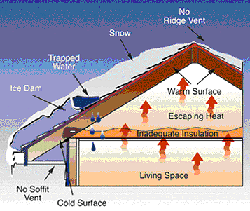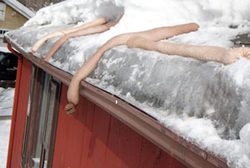How to remove ice dams from roof safely.
Winter presents homeowners with many unique challenges as the weather changes. Among the winter-fueled obstacles that come each year, ice dams can be one of the most serious. Ice dams that build along the edges of the roof can add to the amount of snow and precipitation that will accumulate. A snow-packed roof is bad news. Preventing the accumulation of ice on the roof edge should be a regular part of every homeowner’s annual winter preparation.
Ice dams form because of the roof’s uneven temperature. The roof becomes heated directly above the interior spaces of the house.  However, this heat does not reach the edges and the overhang. As a result, melted snow and rain will flow to these areas where it will freeze once again. Allowing your roof to maintain an even temperature starts with insulation. Your goal is to stop warm air in the house from flowing into the attic. To do this, seal all the gaps in addition to ensuring that all of the insulation is in good shape. The ideal temperature for the roof deck itself is 30 Fahrenheit. When the entire roof maintains a consistent temperature, the snow eventually clears evenly and naturally. It is also critical to have good ventilation between the roof deck and the insulation. Poor ventilation leads to the accumulation of moisture in this area. Excess moisture compounds your problems by encouraging lamination deterioration and mold growth.
However, this heat does not reach the edges and the overhang. As a result, melted snow and rain will flow to these areas where it will freeze once again. Allowing your roof to maintain an even temperature starts with insulation. Your goal is to stop warm air in the house from flowing into the attic. To do this, seal all the gaps in addition to ensuring that all of the insulation is in good shape. The ideal temperature for the roof deck itself is 30 Fahrenheit. When the entire roof maintains a consistent temperature, the snow eventually clears evenly and naturally. It is also critical to have good ventilation between the roof deck and the insulation. Poor ventilation leads to the accumulation of moisture in this area. Excess moisture compounds your problems by encouraging lamination deterioration and mold growth.
Soffit vents are also a valuable tool for fighting ice dams. These kinds of vents allow cold air to circulate beneath the entirety of the roof. Additional material that ensures seals may be needed during the winter as well. Adding extra insulation in extreme conditions never can hurt. Ice damming could also be related to the deterioration of the flashing around chimneys and other roof gaps. Sealing and insulating ducts and duct pipes that flow through the roof and attic also keeps heat from leaking towards the underside of your roof. Fiber-reinforced mastic on the joints of HVAC ducts can do wonders for heat retention.
In the event that you are experiencing ice dams during the winter, there are a few symptoms that indicate that you may have a problem. Ice dams on the roof will cause specific areas of the roof to transmit cold temperatures. Despite insulation, the area where the ice dam has formed will transmit its lower temperatures through to the trusses that connect with your ceiling. As this cold spot comes in contact with the home’s warm air, condensation occurs. The moisture traps dust and eventually forms mildew that will appear darker than the rest of the ceiling. When this occurs, begin by bleaching the mildewed surface. In some cases, this cleaning will be enough to remedy the problem. However, excessive staining can require a stain-blocking primer and a layer of paint. Should the trusses become cold enough to actually shift as they contract, you are likely to see cracks appear along the joint of the ceiling and the wall. These cracks can be caulked temporarily. The best long-term solution is to cover the joints with molding. Attach the molding only to the ceiling so that it is free to move with the structure as the temperatures fluctuate.
Tips to help with ice dams
Making a homemade Ice melt socks by using old panty hose can create melt channels in the ice dam. These channels will allow melted  water from your roof to drain off your roof, reducing the ice dam effect. This method may look & sound funny, but it is one of the safest way to create a melting path without heating cables or chipping away at ice dams. Make sure you use ice melter that is safe for your roof, check with your local hardware expert on this prior to using.
water from your roof to drain off your roof, reducing the ice dam effect. This method may look & sound funny, but it is one of the safest way to create a melting path without heating cables or chipping away at ice dams. Make sure you use ice melter that is safe for your roof, check with your local hardware expert on this prior to using.
Always take caution when attempting to remove any ice damn, consult with a professional first. Your safety comes first.
